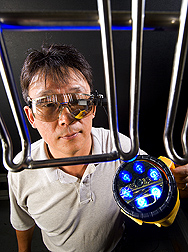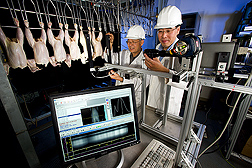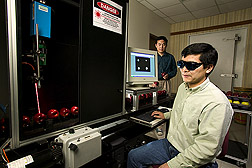Machine’s Eye View of Poultry and Produce
|
|
Take another look at the hardhat and safety glasses on the food safety inspector. Mounted on the hardhat is a small camera and a flashlight that gives off specially filtered light.
The safety glasses are actually a wearable miniature computer monitor that displays data from a miniature computer on the inspector’s belt. The data tells the inspector whether there is any fecal matter on the processing equipment.
Another inspector might be looking through what at first looks like a pair of ordinary binoculars. But these binocular lenses filter special bands of light to check for disease, defects, or fecal matter on the meat, produce, or equipment.
There’s also a hand-held device that shines filtered light to do a sanitation check of the processing plant. The device has a camera that sends images to another eyewear-mounted computer display. White specks on the image reveal fecal matter.
Although these gadgets sound like something dreamed up by James Bond’s gadget man, cutting-edge prototypes like this actually exist in an Agricultural Research Service lab in Beltsville, Maryland.
|
|
At the Instrumentation and Sensing Laboratory (ISL), a team of scientists—led by Yud-Ren Chen and including biophysicist Moon Kim, agricultural engineer Kuanglin Chao, and visiting scientists from around the globe—design the portable inspection devices.
Chen, Chao, and visiting scientist Chun-Chieh Yang have finished work on a high-speed on-line imaging system for chicken inspection. They are turning over a prototype to industry as part of a cooperative research and development agreement with Stork-Gamco of Gainesville, Georgia, a major manufacturer of chicken-processing equipment. Chen and Kim and biomedical engineer Alan Lefcourt are working on a similar system for inspecting fruits and vegetables.
Because all these systems use optically filtered light and opto-electronics to “see,” they are called “machine vision” or “optical sensing” systems. At the heart of these machine vision systems is a digital multispectral camera that can take photos at different wavelengths simultaneously and can even detect light invisible to the naked eye. The systems include the latest, fastest cameras of this type. All the systems rely on two or three wavelengths chosen to do the best job of seeing special features.
Fully funded by ARS—with additional funds from industry—Chen’s team works with both industry and universities, such as the University of Kentucky and the nearby University of Maryland at College Park.
Sensing Remotely, Close Up
Machine vision using multiple images at selected wavelengths is also being developed for use in remote sensing of Earth by satellite imagery. But its potential for use in monitoring food safety and quality should be even greater, since the sensors are only inches away from the target object, and there is a wider range of applications.
The basic idea of machine vision is to supplement human inspectors with instruments that shine light on every single fruit, vegetable, meat, or poultry product as it speeds by on the processing line faster than ever. Typical lines today can process about 360 fruits per minute or up to 180 poultry carcasses per minute, for example.
The system developed by Chen’s team spots almost all biological conditions that cause inspectors to take a second look at chicken carcasses, such as signs of diseases that pose food safety risks or otherwise mar a chicken’s consumer appeal.
Chen’s team is now focusing its attention on apples, developing a system that could be used for other fresh produce as well. It can detect contaminants on the apple surface, such as fecal matter.
Stephen Delwiche, an agricultural engineer at the ISL, works with colleagues at the ARS Grain Marketing and Production Research Center in Manhattan, Kansas, on high-speed optical inspection of wheat and other grains. He uses near-infrared reflected light to detect proteins in wheat as well as scab and other molds.
Quality More Than Skin Deep
In East Lansing, Michigan, ARS engineer Renfu Lu, who originally worked with Chen at Beltsville, is leading a research team that uses similar optical technologies to judge taste and other quality aspects of produce. He has worked with apples, peaches, and cherries using a prototype optical detector he and colleagues devised that uses laser beams to detect fruit sweetness and firmness.
The team consists of research associates Diwan Ariana and Hyunkwon Noh, visiting assistant professor Yankun Peng, engineering technician Benjamin Bailey, and a Ph.D. graduate student, Jianwei Qin, of Michigan State University (MSU) at East Lansing.
Lu and colleagues are refining the mathematical equations and the imaging sensor used by the prototype to judge the internal quality of fruit. “We should have an improved machine vision prototype for ‘tasting’ apples and other fruit very soon,” Lu says.
He is now expanding the machine vision inspection system to pickling cucumbers, inspecting for bruises and other defects as well as internal quality factors—such as firmness, dry matter content, and color.
“We want to select the best cucumbers—those that are firm, have a fresh green color, and aren’t too soggy,” says Lu.
In terms of acreage planted and crop yields, Michigan is the top state for pickling cucumbers by far, with a value of $30 million a year. And at $150 million a year, pickling cucumbers are also one of the most valuable vegetables in the United States, competing only with tomatoes and sweet corn.
Lu’s research program is also fully funded by USDA, with additional funds from industry, and it partners with MSU’s Biosystems and Agricultural Engineering Department to address priority needs of the produce industry in Michigan and the nation.
When commercialized, Lu’s optical sensors would be used by the fruit industry to sort fruits and vegetables just after they had been picked and again on the processing line. The equipment would likely be blended into existing industry sensors that nondestructively assess superficial visual traits, including size, color, and bruising.
“Such technologies would ensure a consistent premium quality, increase consumer satisfaction, and enhance the U.S. produce industry’s competitiveness and profitability,” Lu says.—By Don Comis, Agricultural Research Service Information Staff..
This research is part of Food Safety (#108) and Quality and Utilization of Agricultural Products (#306), two ARS National Programs described on the World Wide Web at www.nps.ars.usda.gov.
Yud-Ren Chen is with the USDA-ARS Instrumentation and Sensing Laboratory, Bldg. 303, 10300 Baltimore Ave., Beltsville, MD 20705-2350; phone (301) 504-8450, fax (301) 504-9466.
Renfu Lu is in the USDA-ARS Sugarbeet and Bean Research Unit, Michigan State University, East Lansing, MI 48824; phone (517) 432-8062, fax (517) 337-6782.
"Machine’s Eye View of Poultry and Produce" was published in the January 2007 issue of Agricultural Research magazine.









